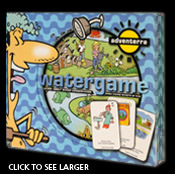

Watergame
Learn about water conservation while having buckets of fun!
DETAILED DESCRIPTION
Watergame is designed to provide an entertaining context for elementary school kids (2nd, 3rd, 4th, and 5th graders) to learn water conservation. We created this half-hour game to inform children about the importance of modifying their behavior to conserve fresh water to ensure that there is enough for everyone. Game cards include concepts, facts, and behaviors that kids can follow in order to conserve water at home and school. Children practice their reading and math skills as they follow instructions on the cards.


The game board consists of a river valley, and players take turns rolling a die and floating down the river, landing on the green fish or red sponges. Green fish teach kids about behaviors that save water and red sponges teach kids about behaviors that waste water.
How to win
To win, players must save the most water and waste the least, thereby filling their individual reservoirs. However, nobody wins if one or more players finish their trip down the river with less than ten gallons of water, so there is an incentive to contribute to the community water jug, from which thirsty players can draw.
The cards
Each green card contains a behavior that conserves freshwater (e.g., report leaky faucet promptly to school authorities), whereas each red card contains a behavior that wastes or pollutes water (e.g., wash hands with faucet turned on full blast).
The Teacher’s Manual
The Teachers’ Manual is based on the U.S. National Science Education Standards; the game and the supplemental exercises included can be used to help students to achieve the learning goals in those standards. The guidebook contains a narrative, statistical information about water sources, water pollution, and water usage throughout the world.
The Children’s Manual
While awaiting their turn the players can read the 16 page illustrated Children’s Manual. Tad the frog tells them all about water conservation and water use around the world – why, how, and where to get additional information.
Additional didactic material
Several loose-leaf diagrams are provided so that teachers can project them or photocopy them for students. These diagrams show the water cycle, how water filters through the earth, how water becomes polluted, and the amount of household water used every year by, for example, the average American and Indian family.
List of Watergame components
- Game box
- Game board (made of Kenaf, a tree-free heavy-duty paper).
- Two decks of behavior cards
- One deck of question cards based on the National Science Education Curriculum Standards.
- Four colored animal-shaped wooden movement tokens and four wooden matching-colored square water reservoir indicators.
- One wooden indicator for the level of water in the community water jug.
- One wooden die.
- A 16 page illustrated Children’s Manual
- A longer Teacher’s Manual.
- Several loose-leaf sheets containing supplemental didactic materials in the form of diagrams
- A brief questionnaire soliciting feedback on how to improve the game.
